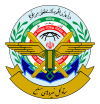
An unmanned aerial vehicle (UAV), commonly known as a drone, is an aircraft without any human pilot, crew, or passengers on board. UAVs were originally developed through the twentieth century for military missions too "dull, dirty or dangerous" for humans, and by the twenty-first, they had become essential assets to most militaries. As control technologies improved and costs fell, their use expanded to many non-military applications. These include aerial photography, precision agriculture, forest fire monitoring, river monitoring, environmental monitoring, policing and surveillance, infrastructure inspections, smuggling, product deliveries, entertainment, and drone racing.

An unmanned combat aerial vehicle (UCAV), also known as a combat drone, colloquially shortened as drone or battlefield UAV, is an unmanned aerial vehicle (UAV) that is used for intelligence, surveillance, target acquisition, and reconnaissance and carries aircraft ordnance such as missiles, ATGMs, and/or bombs in hardpoints for drone strikes. These drones are usually under real-time human control, with varying levels of autonomy. Unlike unmanned surveillance and reconnaissance aerial vehicles, UCAVs are used for both drone strikes and battlefield intelligence.

UAVs include both autonomous drones and remotely piloted vehicles (RPVs). A UAV is capable of controlled, sustained level flight and is powered by a jet, reciprocating, or electric engine. In the twenty first century technology reached a point of sophistication that the UAV is now being given a greatly expanded role in many areas of aviation.

The HESA Ababil is an Iranian family of single-engine multirole tactical unmanned aerial vehicles manufactured by Iran Aircraft Manufacturing Industrial Company (HESA). The Ababil comes in four main lines, the Ababil-2 ,3, 4 and 5, of which the Ababil-2 has a number of variants. It is considered a long-range, low-technology drone.

The Qods Mohajer is an Iranian single-engine tactical unmanned aerial vehicle (UAV) built by the Qods Aviation Industry Company in four main variants from the 1980s to the present day. The Mohajer family is primarily used for reconnaissance, and is among the most mature and well-known Iranian UAVs.
Qods Aviation Industry Company is an Iranian state-owned aerospace company established in 1985. It specializes in UAVs.

The HESA Karrar is an Iranian jet-powered target drone manufactured by Iran Aircraft Manufacturing Industrial Company (HESA) since 2010. The Karrar is a derivative of the American 1970s-era Beechcraft MQM-107 Streaker target drone, probably incorporating elements from the South African Skua, with hardpoints added for munitions. The Karrar was developed during the Ahmadinejad presidency.

The Shahed 129 is an Iranian single-engine medium-altitude long-endurance unmanned combat aerial vehicle (UCAV) designed by Shahed Aviation Industries for the Islamic Revolutionary Guard Corps (IRGC). The Shahed 129 is capable of combat and reconnaissance missions and has an endurance of 24 hours; it is similar in size, shape and role to the American MQ-1 Predator and is widely considered as one of the most capable drones in Iranian service.

Raad or Ra'd is an Iranian modern aerial defence system deployed in September 2012.The system is designed to enhance Iran's capabilities in terms of defense, and as a partner to Bavar 373 air defense system. According to Fars news agency the Raad is designed to confront fighter jets, cruise missiles, smart bombs, helicopters and drones. The system is also designed specially for US fighters. The system is equipped with "Taer" (Bird) missiles, which can trace and hit targets in ranges up to 105 km and in altitudes from 25 to 27 km, Ra'd is a mid-range radar system and air defense system.

The Qods Yasir, also known as the Sayed-2, is an Iranian light tactical surveillance and reconnaissance unmanned aerial vehicle (UAV) manufactured by Qods Aviation. It is ostensibly an unlicensed copy of an American Boeing Insitu ScanEagle drone captured and reverse-engineered by Iran, but has some design changes.

The Krasukha is a Russian mobile, ground-based, electronic warfare (EW) system. This system is produced by the KRET corporation on different wheeled platforms. The Krasukha's primary targets are airborne radio-electronics and airborne systems guided by radar. The Krasukha has multiple applications in the Russian Armed Forces.

The Saegheh is an Iranian turbofan/piston-powered flying wing unmanned combat aerial vehicle (UCAV) produced by Shahed Aviation Industries. It is based on, but smaller than and substantially different from, a Lockheed Martin RQ-170 Sentinel UAV that was captured by Iran in 2011 and then reverse-engineered. It is one of two Iranian flying wing UAVs based on the RQ-170, along with the Shahed 171 Simorgh, a larger version.
A loitering munition is an aerial weapon system category in which the munition can loiter around the target area for some time and attacks only once a target is located. Loitering munitions enable faster reaction times against concealed or hidden targets that emerge for short periods without placing high-value platforms close to the target area, and also allow more selective targeting as the attack can be changed midflight or aborted.
Nasr-e Basir is an Iranian anti-ship cruise missile that was unveiled on August 24, 2014, during a defense exhibition in Tehran, along with other military equipment such as Ghadir missile, Karrar-4 MALE UAV, and Mohajer-4 UAV. It is an indigenous smart low-observable missile designed to target ships. [1]

The Mohajer-6 is an Iranian single-engine multirole ISTAR UAV capable of carrying a multispectral surveillance payload and/or up to four precision-guided munitions.
The Shahed 149 Gaza or, is an Iranian unmanned combat aerial vehicle (UCAV) operated by the Iranian Revolutionary Guard. It was unveiled on 21 May 2021 and named after the Gaza Strip in honor of the Palestinians' struggle against Israel amid the 2021 Israel–Palestine crisis. It was delivered to the IRGC Aerospace Force in 2022.
In the mid-1980s, Iran became interested in unmanned aerial vehicles (UAVs). Iranians have since began manufacturing (UAVs). As an attack munition rather than intelligence, surveillance, or reconnaissance (ISR) platform, the first generation Ababil appears to have been deployed during the Iran–Iraq War.













